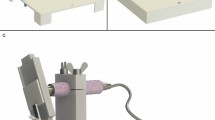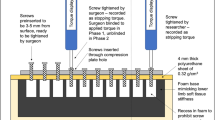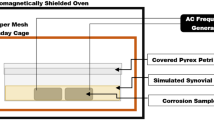Abstract
IN an earlier communication1 attention was directed to the transfer of metal which can occur between a screwdriver tip and a screw head during the operation of screwing, and the possible significance this might have in orthopædic surgery was discussed. It was demonstrated by a radioactive tracer method that, whenever a screw is inserted, small fragments of metal are plucked out of the driver and remain adhering to the screw head. It was suggested that, although the amount of metal transferred is very small (about 10–100 µgm.), the particles may form corrosion centres and cause metal ions to pass into the surrounding tissue. This may cause tissue reaction and interfere with normal physiology even in cases where no gross corrosion is observed.
This is a preview of subscription content, access via your institution
Access options
Subscribe to this journal
Receive 51 print issues and online access
$199.00 per year
only $3.90 per issue
Buy this article
- Purchase on SpringerLink
- Instant access to full article PDF
Prices may be subject to local taxes which are calculated during checkout
Similar content being viewed by others
References
Bowden, F. P., Williamson, J. B. P., and Gowans Laing, P., Nature, 173, 520 (1954).
Tipton, I., Report on the Spectrographic Determination of Trace Elements in Human Tissues, Univ. of Tennessee, Subcontract 380. W-4705 eng-26, March 1953.
Bowden, F. P., and Tabor, D., “The Friction and Lubrication of Solids”, revised edit. (Oxf. Univ. Press, 1954).
Author information
Authors and Affiliations
Rights and permissions
About this article
Cite this article
BOWDEN, F., WILLIAMSON, J. & GOWANS LAING, P. Significance of Metallic Transfer in Orthopædic Surgery. Nature 174, 834–835 (1954). https://doi.org/10.1038/174834b0
Issue date:
DOI: https://doi.org/10.1038/174834b0



